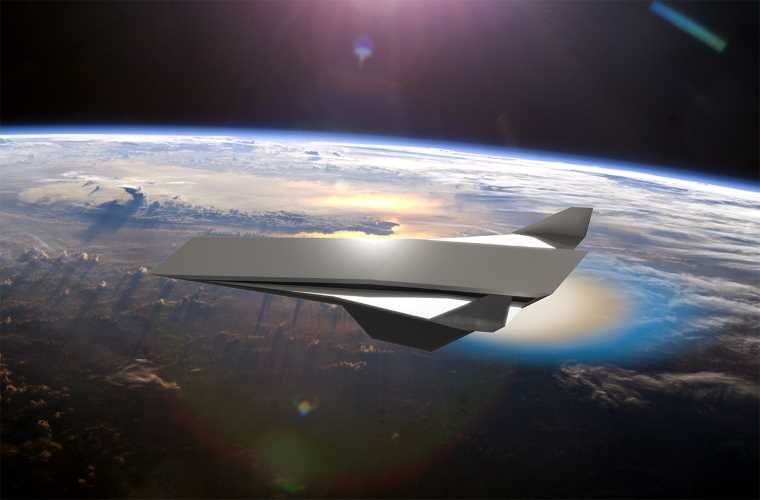A novel propulsion system developed by a team from the University of Central Florida and the U.S. Naval Research Laboratory allows for flight speeds between Mach 6 to Mach 17 (about 4,600 to 13,000 miles per hour), and the technology was inspired by supernovae, the explosion that occurs when a star dies.
In a paper published on Monday in the Proceedings of the National Academy of Sciences, the research team was able to stabilize the detonation required for a jet engine to reach hypersonic speed. Creating a “hypersonic reaction chamber” inside a modified jet engine, the system could allow for speeds reaching 13,000 miles per hour, or Mach 17.
Background: Detonation-Based Propulsion
According to the study, near future propulsion will still rely on either chemical or nuclear-based systems. This means that we will still travel using exothermic reactions via some form of combustion wave.
The study focuses its attention on a specific type of combustion wave caused by detonations. In straightforward terms, something inside the engine goes ‘boom,’ creating high-pressure exhaust, which pushes the vehicle along an intense wave. The inherent problem with detonation-based combustion is that it is unstable. You can make a short millisecond-long intense ‘boom’, and off you go. However, due to the short time frame of the detonation, the process was challenging to study and somewhat impractical for use in vehicles. To maintain high speeds, you need to generate many explosions quickly, and you burn a lot of fuel doing it.
To make this type of propulsion useful, the detonation needs to be sustained for a more extended period. The ‘boom’ has to be dragged out over a couple of seconds. Looking to the stars, the team drew inspiration from the explosive forces created by a star when it enters its final death throes; a supernova.
Analysis: Using Exploding Stars To Go Hypersonic
“[This propulsion system] is inspired by our work published in Science on supernova explosions,” Dr. Kareem Ahmed, an associate professor in UCF’s Department of Mechanical and Aerospace Engineering, told The Debrief.
In simple terms, when certain white dwarf stars explode, the flames of the explosion begin at subsonic speeds, but instead of simply speeding up, they evolve into being driven by supersonic shockwaves, which increases their power. While we are not sure why this happens, Ahmed and his team establish that the energy must detonate into a supersonic wave for the supernova to consume all the star’s material. According to their paper, these detonations occur after the initial blast when the flames of the supernova slam into one another, creating extremely high pressure and turbulence. The right mix of chemicals, heat, pressure and turbulence within a chemical or thermonuclear flame will create what Ahmed calls a “runaway process,” and detonation occurs, creating shockwaves.
The team was able to reproduce these shockwaves in a lab, and since it was possible to contain the detonation for study, the next step was to see if it could be harnessed for use. In other words, taking the explosive reactions that occur in the flames of exploding stars and strapping them to a vehicle.
The team built a hypersonic reaction chamber, called a hypersonic high-enthalpy reaction, or “HyperREACT,” facility. Unlike previous detonation propulsion models, which use ‘rotating detonation,’ HyperREACT uses ‘oblique detonation’ by forcing the explosive reaction down a 30 degree angled ramp built inside the engine’s reaction chamber near where the propellant chemicals mix. When the detonation occurs inside the engine, it is forced down the ramp to maintain its stability, and the shockwaves are stationary (instead of spinning like in rotating detonation).


“This is the first time a detonation has been shown to be stabilized experimentally,” Ahmed said in a press release. “We are finally able to hold the detonation in space in oblique detonation form. It’s almost like freezing an intense explosion in physical space.”
According to the study, instead of the detonation lasting a millisecond, it lasted three seconds. This means that the engine burns less fuel because it doesn’t need to create detonations every millisecond. More importantly, because the duration of the detonation lasts about three seconds, the top speed of this propulsion system is a staggering and vomit-inducing Mach 17. To put it into perspective, “the NASA space shuttle traveled Mach 10 to 25 upon re-entry,” Ahmed explained.
Outlook: Can I Take My Kids on a Hypersonic Flight to Disneyworld?
The next step will be to fine-tune the experiments to develop the perfect engine and chemical mixtures. It is still in the initial stages and needs tweaking. However, because detonation propulsion uses already available fuel, the road map to building a working model is a lot shorter than developing something completely novel.
Dr. Ahmed told The Debrief that this technology could be used for “both ultra-fast intercontinental travel (e.g., N.Y. to London in less than 5 minutes), and for commercial space activities and interplanetary travel.”
He believes that this “high-power and more efficient rocket propulsion technology in a smaller form makes space travel more economical.”
All parents who have experienced taking their children onto a cramped airplane wish the flight would only last a few minutes versus many long hours. Ripping to Disneyworld from Seattle in only two minutes is every parent’s fantasy. While traveling faster than the speed of sound for commercial flights was prominent in the 1980s with the Concorde (a top speed of Mach 2), riding inside a vehicle using an oblique detonation propulsion system will not come with coloring books, little bags of cookies, or mini bottles of Scotch (for the parents). It would be akin to sitting in a rocket heading into space.
“It will be cabins like those used for commercial space travel. It will be short travel times on the order of minutes,” Ahmed stated. “Definitely strap in. It will be fast.”
Follow MJ Banias on Twitter @mjbanias.
Don’t forget to follow us on Twitter, Facebook, and Instagram, to weigh in and share your thoughts. You can also get all the latest news and exciting feature content from The Debrief on Flipboard, and Pinterest. And subscribe to The Debrief YouTube Channel to check out all of The Debrief’s exciting original shows: The Official Debrief Podcast with Michael Mataluni– DEBRIEFED: Digging Deeper with Cristina Gomez –Rebelliously Curious with Chrissy Newton

